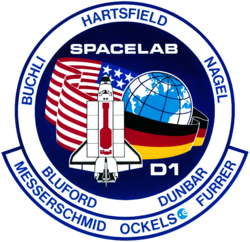Bonnie J. Dunbar
| Bonnie Jeanne Dunbar | |
 | |
| NASA-astronaut | |
|---|---|
| Född | 3 mars 1949 Sunnyside, Washington |
| Tid i rymden | 50 dagar, 8 timmar, 24 minuter[1] |
| Urvalsgrupp | Astronautgrupp 9 |
| Uppdrag | STS-61-A, STS-32, STS-50, STS-71, STS-89 |
| Uppdragsemblem | |
Bonnie Jeanne Dunbar, född 3 mars 1949 i Sunnyside, Washington, är en amerikansk astronaut uttagen i astronautgrupp 9 den 19 maj 1980.
Hon var tidigare gift med den amerikanske astronauten Ronald M. Sega.
Rymdfärder
Rymdfärdsstatistik
| Färd | Datum | Tid | EVA |
|---|---|---|---|
| STS-61-A | 30 oktober - 6 november 1985 | 168:44:00 | 0:00:00 |
| STS-32 | 9 - 20 januari 1990 | 261:00:00 | 0:00:00 |
| STS-50 | 25 juni - 9 juli 1992 | 331:30:00 | 0:00:00 |
| STS-71 | 27 juni - 7 juli 1995 | 235:22:00 | 0:00:00 |
| STS-89 | 22 - 31 januari 1998 | 211:47:00 | 0:00:00 |
| Totalt | 1208:23:00 | 0:00:00 | |
Källor
- ”Biographical Data” (på engelska) (PDF). NASA. 9 2005. https://www.nasa.gov/wp-content/uploads/2016/01/dunbar_bonnie.pdf?emrc=8668c0. Läst 2 maj 2024.
Referenser
- ^ ”Spacefacts” (på engelska). Spacefacts. http://www.spacefacts.de/bios/astronauts/english/dunbar_bonnie.htm. Läst 22 januari 2018.
|
Media som används på denna webbplats
* In the STS-89 crew insignia, the link between the United States and Russia is symbolically represented by the Space Shuttle Endeavour and Russia's Mir Space Station orbiting above the Bering Strait between Siberia and Alaska. The success of the joint United States-Russian missions is depicted by the Space Shuttle and Mir colored by the rising sun in the background.
- A shadowed representation of the International Space Station (ISS) rising with the sun represents the future program for which the Shuttle-Mir missions are prototypes. The inside rim of the insignia describes the outline of the number eight representing STS-89 as the eighth Shuttle/Mir docking mission.
- The nine stars represent the nine joint missions to be flown of the program and when combined with the number eight in the rim, reflect the mission number. The nine stars also symbolize the children of the crew members who will be the future beneficiaries of the joint development work of the space programs of the two countries.
- Along the rim are the crew members' names with David A. Wolf's name on the left and Andrew S. W. Thomas' name on the right, the returning and upgoing cosmonaut guest researcher crew members. In between and at the bottom is the name of Salizan S. Sharipov, payload specialist representing Russian Space Agency (RSA), in Cyrillic alphabet.
- The other crew members are Terrence W. Wilcutt, commander; Joe F. Edwards, Jr., pilot; and mission specialists Michael P. Anderson, Bonnie J. Dunbar, and James F. Reilly. The red, white and blue of the rim reflect the colors of the American and Russian flags which are also represented in the rim on either side of the joined spacecraft.
STS-32 Mission Insignia
- The STS-32 patch, designed by the five crewmembers for the January, 1990 space mission, depicts the Space Shuttle orbiter rendezvousing with the Long Duration Exposure Facility (LDEF) satellite from above and the Syncom satellite successfully deployed and on its way to geosynchronous orbit. Five stars represent the mission number with three on one side of the orbiter and two on the other. The seven major rays of the sun are in remembrance of the crewmembers for STS 51-L. In preparation for the first Extended Duration Orbiter (EDO) missions, STS-32 conducted a number of medical and middeck scientific experiments. The caduceus on the left represents the medical experiments, and the crystalline structure on the right represents the materials science. The crew is comprised of Astronauts Daniel C. Brandenstein, James D. Wetherbee, Bonnie Dunbar, Marsha S. Ivins, and G. David Low.
STS-61A Mission Insignia
- This insignia was chosen by the eight members of the STS-61A/D1 Spacelab mission to represent the record-sized Space Shuttle crew. Crewmembers surnames surround the colorful patch scene depicting Challenger carrying a long science module and an international crew from Europe and the United States.
STS-71 Mission Insignia
The STS-71 crew patch design depicts the orbiter Atlantis in the process of the first international docking mission of the Space Shuttle Atlantis with the Russian Space Station Mir. The names of the 10 astronauts and cosmonauts who flew aboard the orbiter are shown along the outer border of the patch. The rising sun symbolizes the dawn of a new era of cooperation between the two countries. The vehicles Atlantis and Mir are shown in separate circles converging at the center of the emblem symbolizing the merger of the space programs of the two space faring nations. The flags of the United States and Russia emphasize the equal partnership of the mission. The joint program symbol at the lower center of the patch acknowledges the extensive contributions made by the Mission Control Centers (MCC) of both countries. The crew insignia was designed by aviation and space artist, Bob McCall, who also designed the crew patch for the Apollo Soyuz Test Project (ASTP) in 1975, the first international space docking mission.
STS-71 Mission Specialist Bonnie J. Dunbar suits up
Emblem of Nasa's STS-50 mission.






